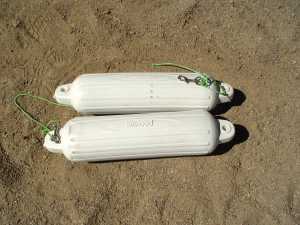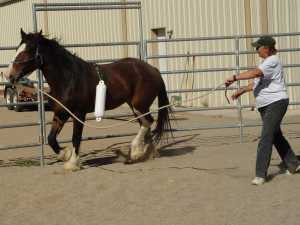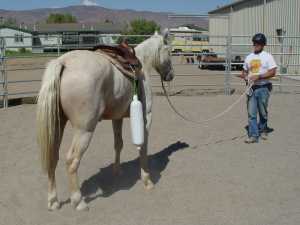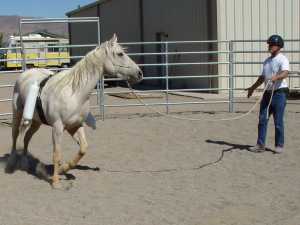Using Boat Bumpers
|
Attwood boat bumpers
|
|
Saddle starting can be a challenging experience for some horses. They have to balance the weight of a rider, respond to cues, ignore the sight and movements of the rider that don't relate to cues, tolerate contact on multiple places on their bodies, etc. It can be a bit much for some horses to rationally process and make sense of.
We'd rather not let the horse blow up (buck, bolt, run off, etc.) before gaining control of his senses. Our preference is to break the saddling process down into individual components that the horse can process and understand. When the horse is comfortable with one component we then add the next component until the trainer is comfortably in the saddle and the horse is comfortable packing the trainer. One element that trainers have to deal with involves some horses' reactions to riders' legs blocking their rear vision as well as inadvertent leg contact by the rider when the horse is in motion. Some horses may initially bolt off from this stimulus. If the rider is handy and can bend the horse around, no harm is done. However if the horse engages in a "blind bolt," engages in a mindless bucking fit, gets his legs tangled up or loses his balance, the situation can quickly become chaotic. A number of trainers have come up with ideas designed to get the horse used to the sight and feel of riders' legs while working the horse in a more controlled environment. These ideas range from placing a young, very competent rider on the horse while longeing it, to filling a pair of jeans with sand, placing the jeans on the saddle and tying the legs to the stirrups. We found something simpler, easier and safer. We simply purchased some Attwood boat bumpers from the sporting goods department at our local Wal-Mart store. (Please see Training Horses the Wal-Mart Way.) |
|
The boat bumpers come in different sizes. We picked out ones that most closely resembled the shape and feel of the lower legs of a rider. With a little heavy twine and some spring clips from the hardware department we were ready to go out and have some fun.
Before you start with an untrained horse... The bumpers can be attached to circingles and saddles. There is a bit of technique, however, with respect to how long the strings should be, where the bumpers should be attached, etc. We recommend that you figure out these aspects on a well broke horse so you can competently configure the bumpers to behave the way you wish at walk, trot and canter. |
Working out the details on a |
| Training with Bumpers |
|
Before we attach bumpers to any horse, the horse needs to be tolerant of being touched with strange objects. We will first desensitize the horse with a
thumper. Then the horse needs to wear a circingle or pack a saddle without fear. This training process should challenge the horse but there is no advantage in making the horse afraid.
That said, our first objective is to introduce the bumper to the horse. If the horse shies from the sight of the bumper, we'll walk away, leading the horse and let the horse pursue the scary object. (Horses are naturally more curious of scary things that are moving away, rather than towards them. We want the horse to learn, not merely bear the experience.) Once the horse is no longer frightened at the sight of the bumper, we will rub him all over with it until he is not afraid of being touched by it. Then we will attach bumpers to each side of the circingle or saddle and let the horse relax with the bumpers hanging on one or both sides. These steps may require a bit of positive reinforcement, depending on the native temperament of the horse being trained. Next we'll ask the horse to move out quietly using a familiar longe pattern. The horse will likely react to the movement and feel of the bumpers so the idea here is to maintain quiet control of the longe line so the horse always focuses on the trainer. If the horse does bolt, we will maintain some tension on the line so that we can regain his focus once he returns to his senses. |
Standing quietly with the bumpers
|
|
At this point it is important to frequently reverse directions. In most cases the horse will be bent to the circle and will naturally see the bumper on the inside of the circle but will be blind to the bumper on the outside. He needs to pick up the bumper with that "blind eye" without startling.
Once the horse will longe confidently in each direction, we'll do a drill that we call the "bow tie" where we ask the horse to longe back and forth in front of us and change directions when he reaches the end of the line. (Please see Longe Line Logic for details.) Key point! When changing directions the horse may startle and rush forward when he first notices the bumper in his formerly "blind" eye. Do not place yourself directly in front of the horse when asking for this maneuver! |
Continue to Part Two
|
Important Note: If you take on the project of developing an untrained horse, everybody will want to give you advice. Don't act on any advice, including the ideas offered in this site, unless it makes sense to you and fits your individual situation. Your abilities and the sensitivities of your horse(s) may differ from the examples given. Be alert and rational with your actions so neither you nor your horse will get hurt. This information is offered as illustrations of what we do and the reader must apply common sense since he or she is solely responsible for his or her actions. Happy trails!Press "Back" to return to the page that brought you hereGo to Case Study SectionReturn to Training SectionReturn to Wild Horse MentorsReturn to KBR World of Wild Horses and BurrosGo To
|




